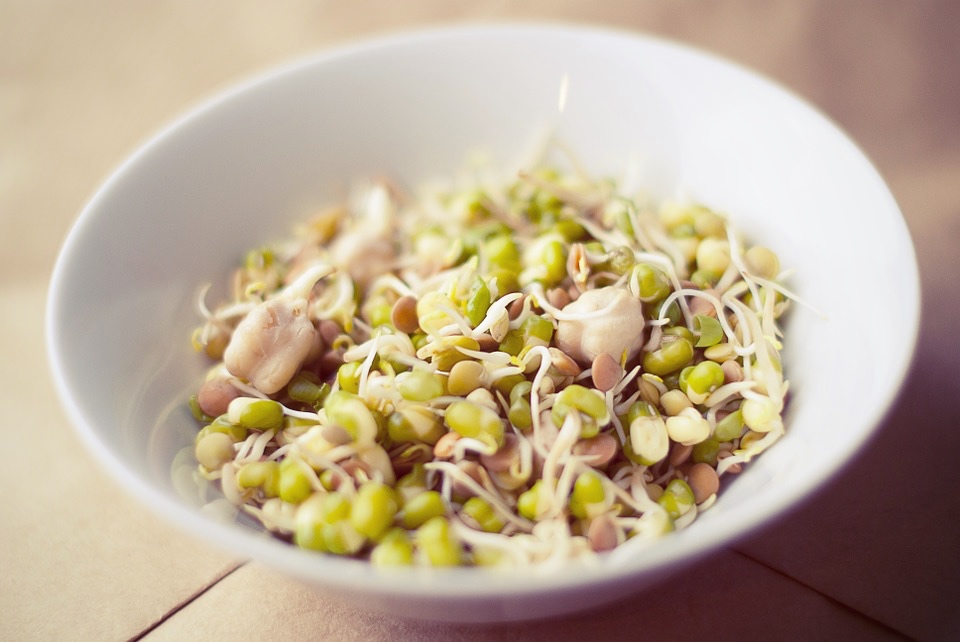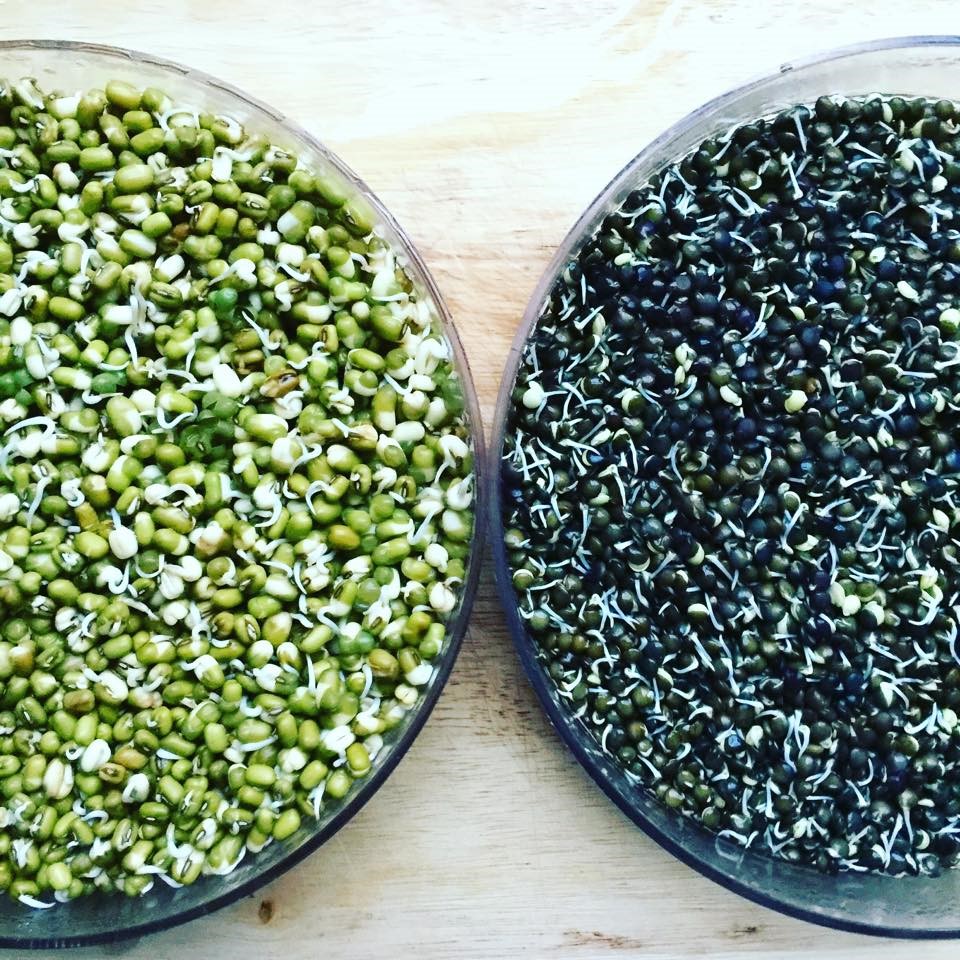In my last blog we covered the importance and benefits of soaking your grains, nuts, legumes, seeds etc. in this blog we will go one step further and look into why sprouting your grains can do so much more for your health than you think. You probably eat sprouted grains when you eat your egg and cress sandwiches or when you eat Chinese and love the taste of crunchy bean sprouts. So here’s why we should eat so much more than we already do.

Sprouting is the process of germinating seeds, nuts, grains and beans. It involves soaking them and then rinsing them every 8-12 hours until they begin to develop a tail-like protrusion. At this stage they become easier to digest and easier for the body to absorb their nutrients.
Soaking is sometimes confused with sprouting, which, as mentioned, is actually the first step in the sprouting process. Soaking softens the hull, allows the sprout to grow and then sprouting allows the soaked item to germinate further. You first must soak something before you can sprout it.
Sprouts have a long history of being used for more than 5,000 years ago in Chinese medicine where physicians prescribed them for curing many disorders for their nutritional and medicinal properties.
It is only in the past thirty years that “westerners” have become interested in sprouts and sprouting. During World War II considerable interest in sprouts was sparked in the United States by an article written by Dr Clive McKay, Professor of Nutrition. Dr McKay announced: “Wanted! A vegetable that will grow in any climate, will rival meat in nutritive value, will mature in 3 to 5 days, may be planted any day of the year, will require neither soil nor sunshine, will rival tomatoes in Vitamin C, will be free of waste in preparation and can be cooked with little fuel and as quickly as a … chop.”
Dr McKay was talking about soybean sprouts. He and a team of nutritionists had spent years researching the amazing properties of sprouted soybeans. They and other researchers found that sprouts retain the B-complex vitamins present in the original seed, contain high amounts of vitamin A and C compared to that of the unsprouted seeds. Some nutritionists found that this high vitamin content is gained at the expense of some protein loss, nonetheless, an average 300 percent increase in vitamin A and a 500 to 600 percent increase in vitamin C. In addition to this, the sprouting process converts starches into simple sugars, thus making sprouts easily digested.
Sprouting Benefits
Highly Nutritious
The biggest benefit of sprouts is that they are a powerhouse of nutrients, all of which our body needs, and they’re just there waiting to be unlocked with their maximum potential ready to be used. Just as Dr McKay found, vitamin C, vitamin E and beta-carotene (a form of vitamin A) were all barely detectable in the dry grains. However, sprouting the grains increased their concentrations significantly, with peak concentrations of the nutrients observed after seven days of sprouting.
Other studies have found that nutrients, including amino acids (the building blocks of proteins), sugars in the form of glucose, and even vitamins and minerals become more available and absorbable. Folate also increases in sprouted grains by up to 3.8-fold.
Seed and legumes see a raise in antioxidant levels when sprouted, making them an important aid against free radical and ageing. There is also an increase in the contents of B vitamins, vitamin C, vitamin A and beta-carotene and improved availability of calcium, iron and zinc. Sprouts are the perfect support for skin and immune health.
A 2012 study found that vitamin C levels, phenolic and flavanoid antioxidants, significantly increased in mung bean sprouts when germinated for up to eight days.
Makes Foods Easier to Digest
For many people, eating grains and beans can cause discomfort and adverse reactions. Sprouting is able to activate beneficial enzymes, which make all types of grains, seeds, beans and nuts easier on the digestive system. This also boosts beneficial bacteria in the gut, reducing inflammation and possible autoimmune reactions. It can also be especially beneficial for individuals sensitive to gluten, as sprouted flours can further decrease in gluten content.
Other studies have shown that as time goes on, sprouted flours can further decrease in gluten, while the availability of total amino acids (protein), fats and sugars becomes more easily available.

Increases Protein Availability
Depending on the exact seed that is sprouted, proteins in the form of amino acids can become more concentrated and absorbable in sprouted foods. As sprouting continues, complex proteins are converted into simple amino acids, making them easier on digestion.
Some studies have shown that an increase in amino acids, including lysine and tryptophan, can take place when seeds are sprouted. However, the protein gluten can also decrease in grains when sprouted.
Sprouts rich in protein: sprouted lentils, mung beans, adzuki beans, garbanzo beans and peas.
Decreases Anti-Nutrients and Phytic Acid
Just as I mentioned in my last blog, germination lowers the levels of anti-nutrients, such as phytic acid, lectins, saponins and enzyme inhibitors. Anti-nutrients are naturally occurring compounds that protect plants in nature but they can block the absorption of essential vitamins and minerals by the body.
Phytic Acid- found in grains and beans binds to calcium, copper, iron, magnesium and zinc, inhibiting their uptake and our digestive enzymes. It also inhibits our digestive enzymes called amylase, trypsin and pepsin. Amylase breaks down starch, while both pepsin and trypsin are needed to break down protein into smaller amino acids.
Enzyme Inhibitors- found in nuts and seeds may prevent adequate digestion. They can cause protein deficiency and gastrointestinal upset. Tannins are enzyme inhibitors. So are other difficult-to-digest plant proteins like gluten. Enzyme inhibitors not only cause digestive problems, but they can contribute to allergic reactions and mental illness.
Lectins and Saponins— present in legumes and vegetables affect the gastrointestinal lining, contributing to leaky gut syndrome and various autoimmune disorders. Lectins are particularly resistant to digestion by humans. They enter our blood and trigger immune responses. Lectins can cause GI upset similar to classical food poisoning and immune responses like joint pain and rashes. Improperly prepared raw grains, dairy and legumes like peanuts and soybeans have especially high lectin levels.
Polyphenols— inhibit digestion of copper, iron, zinc and vitamin B1, along with enzymes, proteins and starches found in plant foods.
Increases Fibre Content
Several studies have found that when seeds are sprouted, their fibre content increases and becomes more available. Reports show that sprouting increases concentrations of crude fibre, which is the fibre that makes up the cell walls of plants. When we consume plant’s crude fibre, the fibre cannot actually be absorbed within our digestive tracts. Therefore it helps push waste and toxins out of the gut and regulate bowel movements.
Helps Reduce Other Allergens Found in Grains
Aside from decreasing gluten protein concentrations, sprouting grains has been shown to help reduce other food allergens (especially one called 26-kDa allergen) that is found in grains like rice.
In one study, researchers found that sprouted brown rice contained much lower levels of two allergen compounds when compared to non-sprouted brown rice. They believed that the reduction was due to certain enzyme activities that took place during sprouting.
Recipes for Health
Below gives the time needed to soak and then sprout various nuts, beans, legumes, grains and seeds:
NUTS
Almonds: Need 2–12 hours for soaking. Sprout for 2–3 days if truly raw. The length you choose depends on what you want to use them for. For example, 48 hours of soaking allow the skins to fall off.
Walnuts: 4 hours soaking, do not sprout
Brazil nuts: 3 hours soaking, do not sprout
Cashews: 2–3 hours soaking, do not sprout
Hazelnuts: 8 hours soaking, do not sprout
Macadamias: 2 hours soaking, do not sprout
Pecans: 6 hours soaking, do not sprout
Pistachios: 8 hours soaking, do not sprout
BEANS AND LEGUMES
Chickpeas: 8–12 hours soaking, 2–3 days for sprouting
Lentils: 8 hours soaking, 2–3 days for sprouting
Adzuki beans: 8 hours soaking, 2–3 days for sprouting
Black beans: 8–12 hours soaking, 3 days for sprouting
White beans: 8 hours soaking, 2–3 days for sprouting
Mung beans: 24 hours soaking, 2–5 days for sprouting
Navy beans: 9–12 hours soaking, 2–3 days for sprouting
Peas: 9–12 hours soaking, 2–3 days for sprouting
* It’s not recommended to sprout red kidney beans as they contain a very toxic lectin*
GRAINS
Buckwheat: 30 minutes–6 hours soaking (time varies), 2–3 days for sprouting
Amaranth: 8 hours soaking, 1–3 days for sprouting
Kamut: 7 hours soaking, 2–3 days for sprouting
Millet: 8 hours soaking, 2–3 days for sprouting
Oat groats: 6 hours soaking, 2–3 days for sprouting
Quinoa: 4 hours soaking, 1–3 days for sprouting
Wheat berries: 7 hours soaking, 3–4 days for sprouting
Wild rice: 9 hours soaking, 3–5 days for sprouting
Black rice: 9 hours soaking, 3–5 days for sprouting
SEEDS
Radish seeds: 8–12 hours soaking, 3–4 days for sprouting
Alfalfa seeds: 12 hours soaking, 3–5 days for sprouting
Pumpkin seeds: 8 hours soaking, 1–2 days for sprouting
Sesame seeds: 8 hours soaking, 1–2 days for sprouting
Sunflower seeds: 8 hours soaking, 2–3 days for sprouting
METHOD
The sprouting method is the same for all foods, the only difference is the amount of time involved:
1. Rinse your grains, seeds or legumes thoroughly and buy some that are free of pesticides and that haven’t been pasteurised or irradiated.
2. Put them in a bowl, cover with water and place some cheese cloth or a kitchen towel on the top.
3. Let soak for the suggested times.
4. Then strain, rinse well and place in a shallow glass container or dish on your kitchen counter so they’re exposed to air.
5. Rinse every 8-12 hours and repeat the process until sprouts appear. They can vary in length from 1-5cm.
6. Once ready, rinse well again, drain and store in a glass jar or container in the refrigerator. They can keep up to 7 days but to avoid the formation of mould or bacteria, make sure to rinse them every day, as well as washing their storing container.
MEAL IDEAS
· Beans and grains, once sprouted, cook faster and are easier to digest. It is best to slightly cook these, while seed and grass sprouts can be eaten raw.
· Add them to salads for extra protein or mix quinoa, buckwheat or wild rice with crunchy vegetables and a zesty citrus vinaigrette.
· Cook sprouted chickpeas or peas and process them into hummus – they will be much lighter in texture than the traditional counterpart.
· Use sprouted flour for baked goods that will be much more easily digested and enjoyed or make your favourite granolas with sprouted oat groats or buckwheat for extra crunch and nutritional value.
· Add radish or broccoli sprouts to your morning juice or smoothie to start the day with a spicy injection of vitamins and minerals, then fill your lunchtime wrap with alfaalfa or sunflower sprouts.
Precautions
As for many foods in their raw stage, sprouts can potentially develop bacteria and cause harmful illnesses. The best way to avoid this possibility is by sanitising all the containers you have used for soaking and sprouting, and carefully rinse the items to sprout for at least one minute, eliminating any dirt and shell fragments. Most importantly, always choose nuts, seeds, grains and legumes that are certified organic and pathogen-free.
To Sum Up…
Nuts, beans and seeds can play an important role in many adults’ diets, contributing a range of different nutrients.
The reason that humans suffer from indigestion and autoimmune reactions from unsprouted foods is because we aren’t designed to break down anti-nutrients in plant compounds that lock up or deplete vitamins, minerals and other nutrients. Regularly consuming high amounts of anti-nutrients can significantly impact your health.
Sprouting and soaking seeds can break down anti-nutrients, make the seeds more digestible and unlock high levels of vitamins, minerals, antioxidants and other healthy compounds found in plant foods. These can all have a positive impact on your nutritional health, be easier of your digestive system and cause less allergic reactions.
Use raw, unsprouted nuts, grains, seeds or legumes that haven’t been roasted, blanched or prepared at all in any way. Place them in a bowl covered with several inches of water, and cover with a kitchen towel. Let them sit for anywhere between 5–48 hours depending on the kind. With a little labour of love, they will soon sprout and be ready to boost your nutritional health to a new level. Add them to your morning smoothie or granola, your lunch time wrap or salad or your evening stir-fry!
Sources
https://www.veganfoodandliving.com/sprouting-ancient-process-becoming-modern-trend/
http://www.isga-sprouts.org/about-sprouts/sprout-history/
https://draxe.com/sprout/
